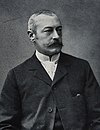| |||||||||||||||||
All 589 seats the Chamber of Deputies 295 seats needed for a majority | |||||||||||||||||
|---|---|---|---|---|---|---|---|---|---|---|---|---|---|---|---|---|---|
| |||||||||||||||||
| |||||||||||||||||
Legislative elections were held in France on 27 April and 11 May 1902. The result was a victory for the Bloc des gauches alliance between Socialists, Radicals, and the left wing of the Republicans, over the anti-Dreyfusard right wing of the Republicans, the progressistes. The Bloc des gauches had been brought together to support the "Republican Defense Cabinet" (gouvernement de défense républicaine) formed by Pierre Waldeck-Rousseau following the assault on the newly elected president, Émile Loubet, on the Longchamp Racecourse on 4 June 1899, during the Dreyfus affair.
However, Waldeck-Rousseau's own supporters (the ARD) took few seats in the election compared to the Radicals and Socialists. After the election, President Loubet invited the Radical Émile Combes to form a government, which lasted until January 1905, when the Socialists withdrew from the Bloc des gauches.
Results
| Party | Votes | % | Seats | |
|---|---|---|---|---|
| Progressive Republicans | 2,501,429 | 29.73 | 127 | |
| Left Republicans | 62 | |||
| Independent Radicals | 1,413,931 | 16.81 | 129 | |
| Nationalists | 1,194,900 | 14.20 | 89 | |
| Reactionaries | 1,188,180 | 14.12 | ||
| Socialists | 531,087 | 6.31 | 43 | |
| Revolutionary Socialists | 344,445 | 4.09 | ||
| Radical-Socialists | 853,140 | 10.14 | 104 | |
| Popular Liberal Action | 385,615 | 4.58 | 35 | |
| Total | 8,412,727 | 100.00 | 589 | |
| Registered voters/turnout | 11,058,702 | – | ||
| Source: France-Politique, Rois et Presidents | ||||
References
- Gildea, R., Children of the Revolution, London, 2008, pp. 278-282
- L'année Politique 1902, by André Daniel, Librairie Académique Perrin, 1903
External links
This French elections-related article is a stub. You can help Misplaced Pages by expanding it. |


